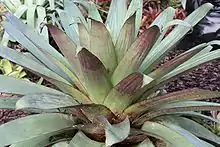Alcantarea imperialis
Alcantarea imperialis is a species of bromeliad in the genus Alcantarea.[1] This species is endemic to Brazil.[1]
| Alcantarea imperialis | |
|---|---|
 | |
| Scientific classification | |
| Kingdom: | Plantae |
| Clade: | Tracheophytes |
| Clade: | Angiosperms |
| Clade: | Monocots |
| Clade: | Commelinids |
| Order: | Poales |
| Family: | Bromeliaceae |
| Genus: | Alcantarea |
| Species: | A. imperialis |
| Binomial name | |
| Alcantarea imperialis | |
It was first described in 1888 as Vriesea imperialis by Élie-Abel Carrière, who dedicated it to the emperor of Brazil with the species epithet, imperialis.[2] It was assigned to the genus, Alcantarea, by Hermann Harms in 1930.[3]
Description
This large terrestrial bromeliad was once classified as Vriesea imperialis but is now recognized as part of the genus Alcantarea. It can be found growing on rocky slopes in the Serra dos Órgãos in Rio de Janeiro. It can tolerate dry conditions and full sunlight. Considered one of the giants of the genus, "its leathery leaves measuring 6 inches in width and 5 feet in length."[4] It will take up to forty years before producing an imposing red inflorescence that reaches 8 feet, or even ten feet (3 meters) in height. Its tank will hold up to thirty liters of rainwater.[5]
 in flower
in flower
 Alcantarea Imperialis - Red Form
Alcantarea Imperialis - Red Form Alcantarea Imperialis - Green Form
Alcantarea Imperialis - Green Form
Cultivars
- Alcantarea 'Ajax'
- Alcantarea 'Black Cinder'
- Alcantarea 'Gladys'
- Alcantarea 'Helenice'
- Alcantarea 'Purple Skotak'
- Alcantarea 'Silver Plum'
- Alcantarea 'Tarawera'
- Alcantarea 'Totara Orange'
References
- "Alcantarea imperialis (Carrière) Harms | Plants of the World Online | Kew Science". Plants of the World Online. Retrieved 2021-12-08.
- Carrière, E.-A. (1888). "Vriesia imperialis". Revue horticole. Paris. 60: 58.
- Harms, H.A.T. (1930) Die natürlichen Pflanzenfamilien, ed. 2 [Engler & Prantl] 15a: 126
- Padilla, Victoria (1973). Bromeliads. New York: Crown Publishers. pp. 104. ISBN 0517562413.
- Martinelli, Gustavo (March 2000). "The Bromeliads of the Atlantic Forest". Scientific American. 282 (3): 86–93.
- Martinelli, Gustavo; Vieira, Cláudia Magalhães; Gonzalez, Marcos; Leitman, Paula; Piratininga, Andréa; Costa, Andrea Ferreira da; Forzza, Rafaela Campostrini (January 2008). "Bromeliaceae da Mata Atlântica Brasileira: lista de espécies, distribuição e conservação" [Bromeliaceae of the brazilian Atlantic Forest: checklist, distribution and conservation]. Rodriguésia (in Brazilian Portuguese). 59 (1): 209–258. doi:10.1590/2175-7860200859114. JSTOR 23499386.
- BSI Cultivar Registry Retrieved 11 October 2009